
A nature reserve, is a protected area of importance for flora, fauna, or features of geological or other special interest, which is reserved and managed for purposes of conservation and to provide special opportunities for study or research. They may be designated by government institutions in some countries, or by private landowners, such as charities and research institutions. Nature reserves fall into different IUCN categories depending on the level of protection afforded by local laws. Normally it is more strictly protected than a nature park. Various jurisdictions may use other terminology, such as ecological protection area or private protected area in legislation and in official titles of the reserves.

Konstantynów Łódzki is a town in Pabianice County, Łódź Voivodeship, Poland, with 17,892 inhabitants (2016). It borders Lodz to the east, Lutomiersk to the West, Aleksandrow Lodzki to the North, and Porszewice to the South. It was incorporated in 1924, but was founded in the 1820s by a landowner who had planned to build a textile industry there.

Krośniewice is a town in Kutno County, Łódź Voivodeship, Poland, with 4,458 inhabitants (2016).

Tuszyn is a small town in Łódź East County, Łódź Voivodeship, central Poland, with 7,280 inhabitants (2016).
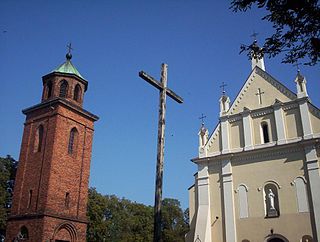
Biała Rawska(listen) is a town in Rawa County, Łódź Voivodeship, Poland, with 3,212 inhabitants (2016).
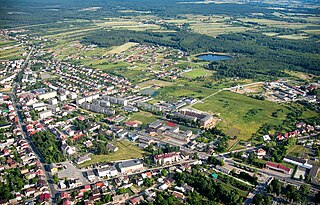
Pajęczno is a town in Poland, in Łódź Voivodeship, about 40 kilometres north of Częstochowa. It is the capital of Pajęczno County. Population is 6,829 (2016).

Poddębice is a town in Poland, in Łódź Voivodeship, about 40 km northwest of Łódź. It is the capital of Poddębice County. Population is 7,630 (2016).
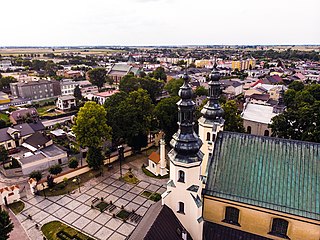
Warta is a town in Sieradz County, Łódź Voivodeship, Poland, with 3,303 inhabitants (2016). It is situated on the Warta River.

Kamieńsk is a town in Poland, in the Łódź Voivodeship, in Radomsko County. As of 2016, it had 2,821 inhabitants.
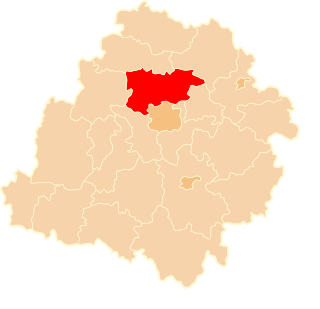
Zgierz County is a unit of territorial administration and local government (powiat) in Łódź Voivodeship, central Poland. It came into being on January 1, 1999, as a result of the Polish local government reforms passed in 1998. Its administrative seat and largest town is Zgierz, which lies 9 kilometres (6 mi) north-west of the regional capital Łódź. The county contains four other towns: Ozorków, lying 16 km (10 mi) north-west of Zgierz, Aleksandrów Łódzki, lying 9 km (6 mi) south-west of Zgierz, Głowno, lying 24 km (15 mi) north-east of Zgierz, and Stryków, lying 15 km (9 mi) north-east of Zgierz.
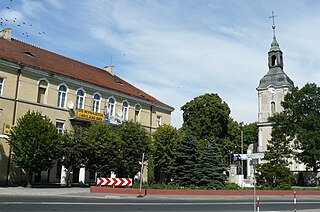
Błaszki is a town in Sieradz County, Łódź Voivodeship, Poland, with 2,196 inhabitants (2016).
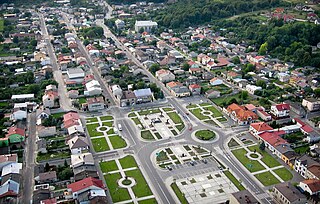
Działoszyn is a town in Pajęczno County, Łódź Voivodeship, Poland, with 6,040 inhabitants (2016).

Rzgów is a town in Łódź East County, Łódź Voivodeship, Poland, with 3,378 inhabitants (2016). It was incorporated as a town from 1467 until 1870, then it was downgraded to a village. On January 1, 2006 it became a town again.

The Borders of Poland are 3511 or 3582 kilometers long. The neighboring countries are Germany to the west, the Czech Republic and Slovakia to the south, Ukraine and Belarus to the east, and Lithuania and the Russian province of Kaliningrad Oblast to the northeast. To the north, Poland is bordered by the Baltic Sea.

Protected areas of Poland include the following categories, as defined by the Act on Protection of Nature of 16 April 2004, by the Polish Parliament:

Szczecin Landscape Park "Beech Woods" is a protected area in north-western Poland, established in 1981 and covering an area of 91 square kilometres (35 sq mi). Its full name refers to the dense forest known as Puszcza Bukowa, which covers most of the area of the Park.

The Pentecostal Church in Poland is a Pentecostal Christian denomination in Poland. It is the largest Pentecostal denomination in Poland and a part of the World Assemblies of God Fellowship. The Pentecostal Church in Poland is a member of Pentecostal European Fellowship and Biblical Society in Poland. Headquartered in the city of Warsaw.
Protestantism in Poland is the third largest faith in Poland, after the Roman Catholic Church (32,910,865) and the Polish Orthodox Church (507,196). As of 2011 there were approximately 80 registered Protestant denominations in Poland, with a total of 145,600 members. Most Protestants in the country live in historically Protestant regions such as Cieszyn Silesia and Warmia-Masuria and in major urban areas. However, almost all urban and rural areas in Poland are predominantly Roman Catholic. The only town in the country with a majority Protestant population is Wisła.

The Belarusian-Polish border is the state border between the Republic of Poland and the Republic of Belarus It has a total length of 398.6 km (247.7 mi), 418 km (260 mi) or 416 km (258 mi). It starts from the triple junction of the borders with Lithuania in the north and stretches to the triple junction borders with Ukraine to the south. It is also part of the EU border with Belarus. The border runs along the administrative borders of two Voivodships Podlaskie and Lubelskie in the Polish side and Grodno and Brest Voblasts in the Belarusian side. In the Polish side, the 246.93 km (153.44 mi) section is under the protection of the Podlaskie Border Guard Unit, while the 171.31 km (106.45 mi) section is in the operation area of the Bug River Border Guard Unit. Border rivers are Czarna Hańcza, Wolkuszanka, Swislocz, Narew, and Western Bug.

The Lutheran Diocese of Warsaw is one of the six dioceses of the Evangelical Church of the Augsburg Confession in Poland, covering most of central and eastern Poland. The Lutheran population in the area in 2016 was 3968, which amounts to about 7% of the total number of adherents of the church in Poland. There were 18 ordained ministers in the diocese in 2016.




















